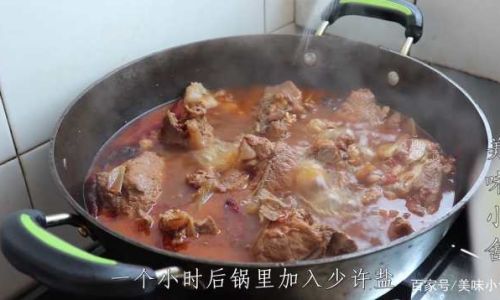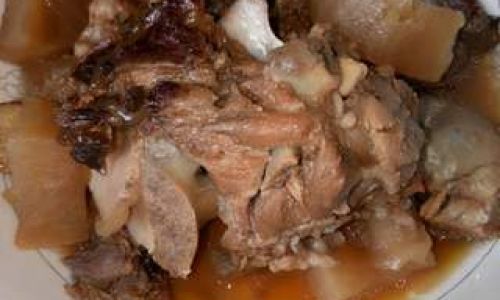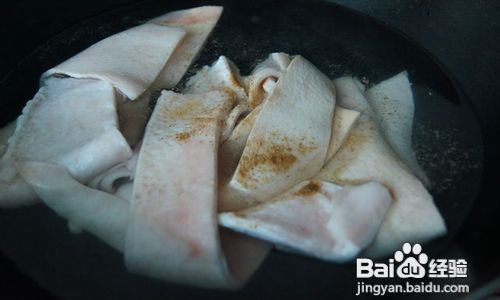Stewing big bones is a culinary tradition that spans cultures and centuries, prized for its ability to transform humble ingredients into a rich, nourishing feast. Whether you’re craving a hearty soup, a comforting stew, or a broth brimming with depth, mastering the technique of stewing large bones is a skill worth honing. This article delves into the science and art of stewing big bones, exploring everything from ingredient selection to flavor-enhancing techniques, ensuring your dish emerges tender, flavorful, and utterly irresistible.
The Foundation: Choosing the Right Bones
Not all bones are created equal. The key to a memorable stew lies in selecting bones with the right balance of meat, cartilage, and marrow. Beef shank bones, oxtail, knuckle bones, and marrow bones are popular choices, each offering unique textures and flavors.

- Beef Shank Bones: These are ideal for stewing due to their high collagen content, which breaks down during slow cooking into gelatin, creating a luxurious, velvety broth.
- Oxtail: Rich in fat and connective tissue, oxtail becomes meltingly tender when stewed, imparting a deep, beefy flavor.
- Marrow Bones: These add unctuous richness and a silky texture to broths, though they contribute less meat.
When purchasing bones, opt for grass-fed or organic varieties if possible, as they often yield cleaner-tasting broth. Ask your butcher to cut the bones into 2–3 inch pieces, exposing the marrow for easier extraction during cooking.
Preparation: Cleaning and Priming the Bones
Proper preparation ensures your stew starts on the right foot. Begin by rinsing the bones under cold water to remove any surface debris. For a clearer broth, soak the bones in cold water for 30–60 minutes, changing the water once or twice. This step helps leach out impurities like blood and bone fragments.
Blanching: A critical step often overlooked, blanching removes residual scum and ensures a cleaner-tasting broth. Place the bones in a large pot, cover with cold water, and bring to a boil over high heat. As soon as the water boils, drain the bones and rinse them under cold water. This process tightens the meat, sealing in juices and reducing cloudiness in the final dish.

Roasting for Depth: For a richer, caramelized flavor, roast the bones before stewing. Preheat your oven to 400°F (200°C), spread the blanched bones on a baking sheet, and roast for 30–40 minutes until golden brown. This step adds complexity to the broth, especially when combined with aromatics like onions, carrots, and garlic.
The Liquid Base: Water vs. Stock
While water can be used, starting with a homemade stock (beef, chicken, or vegetable) elevates the stew’s flavor. If using store-bought stock, opt for low-sodium varieties to control seasoning. For a truly luxurious result, combine equal parts water and stock, allowing the bones to impart their essence without overpowering the broth.
Aromatics and Seasonings: Building Flavor Layers
The magic of stewing lies in layering flavors. Begin by sautéing aromatics in a heavy-bottomed pot or Dutch oven. Classic combinations include:

- Mirepoix: A trio of onions, carrots, and celery, sautéed until softened.
- Aromatic Herbs: Bay leaves, thyme, rosemary, and parsley stems add earthy notes.
- Spices: Black peppercorns, whole cloves, or star anise introduce warmth without overpowering.
- Tomato Paste: A tablespoon or two adds umami and depth, especially when caramelized with the vegetables.
For an Asian twist, incorporate ginger, garlic, star anise, and a splash of soy sauce or fish sauce. In Mexican-inspired stews, chipotle peppers in adobo or cumin seeds lend smokiness.
The Stewing Process: Slow and Low Wins the Race
Stewing is a dance of patience and temperature control. Follow these steps for perfection:
- Sear the Bones: After blanching or roasting, sear the bones in a hot pot with oil until deeply browned. This Maillard reaction develops complex flavors.
- Deglaze: Pour in a splash of red wine, beer, or broth to scrape up the browned bits (fond) from the pot, infusing the stew with depth.
- Simmer Gently: Bring the liquid to a gentle simmer—never a boil—as vigorous heat toughens meat and clouds the broth. Maintain a temperature between 180–200°F (82–93°C).
- Skim Fat: Periodically skim off any foam or fat that rises to the surface to keep the broth clear.
- Cook Time: Allow 3–6 hours for beef bones, depending on the cut. Oxtail and shank require at least 4 hours, while marrow bones may soften in 2–3.
Vegetables: Timing Is Everything
Add vegetables in stages to prevent overcooking:

- Early Additions: Carrots, onions, and celery can be sautéed with the aromatics at the start.
- Mid-Cooking: Heartier vegetables like potatoes, turnips, or parsnips should be added 1–2 hours before serving.
- Late Additions: Delicate greens (kale, spinach) or mushrooms are best added in the final 30 minutes.
Thickening Agents: Natural vs. Added
While collagen-rich bones naturally thicken the broth as they cook, you may opt for additional thickeners:
- Roux: A mixture of flour and butter cooked until golden, whisked into the stew for a velvety texture.
- Cornstarch Slurry: A quick fix—mix cornstarch with cold water and stir into the stew during the final minutes.
- Puréed Vegetables: Blend a portion of the cooked vegetables and stir them back in for a creamy consistency without added starches.
Finishing Touches: Elevating the Final Dish
The last moments of cooking are when flavor and texture are refined:
- Acidity: A splash of vinegar, lemon juice, or a tangy tomato balances richness.
- Fresh Herbs: Chopped parsley, cilantro, or dill add brightness.
- Fat: A drizzle of olive oil or a pat of butter just before serving enriches the broth.
- Garnishes: Crusty bread, grated Parmesan, or a sprinkle of smoked paprika enhance presentation and flavor.
Common Mistakes to Avoid
- Rushing the Process: Stewing requires time; cutting corners results in tough meat and weak flavor.
- Overcrowding the Pot: Ensure bones are submerged in liquid but not crammed, as this lowers cooking temperature.
- Adding Salt Too Early: Salt draws moisture from meat; season only during the final hour.
- Neglecting to Skim: Failure to remove impurities leads to a greasy, cloudy broth.
- Using Lean Bones: Bones with minimal marrow or connective tissue yield thin, unremarkable broth.
Cultural Variations: Global Approaches to Bone Stewing
- Chinese Bone Soup (Tang Pai Gu Tang): Simmered with goji berries, jujube dates, and ginger for a sweet, nourishing broth.
- Vietnamese Pho: Aromatic spices like star anise, cinnamon, and cloves flavor beef bone broth, served with rice noodles and herbs.
- Italian Osso Buco: Veal shanks braised with white wine, tomatoes, and gremolata (a mix of lemon zest, garlic, and parsley).
- Korean Galbi-Tang: Beef short ribs stewed with radish, garlic, and sesame oil, known for its clean, healing properties.
Storing and Reheating: Maximizing Leftovers
Stewed bones improve in flavor over time. Store cooled broth in airtight containers for up to 5 days in the refrigerator or 3 months in the freezer. Reheat gently, adding a splash of water or broth if the stew thickens too much.

Conclusion: The Joy of Slow Cooking
Stewing big bones is an act of patience and reverence for ingredients. It transforms simple elements into a dish that warms the soul, nourishes the body, and connects us to culinary traditions across the globe. Whether you’re a novice cook or a seasoned chef, mastering this technique offers endless opportunities for creativity and comfort. So grab your largest pot, gather your bones, and embark on a journey to stewing perfection—one slow, simmering hour at a time.






0 comments